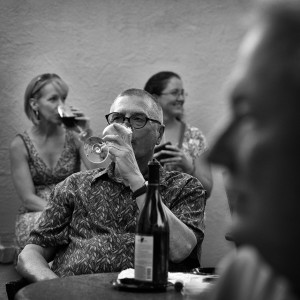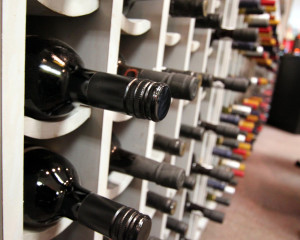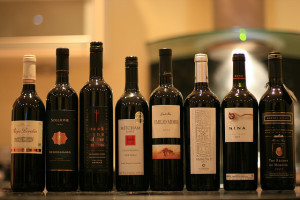A recent Wine Market Council survey found that about 40% of the 240 million adults in the United States
consume wine. Within this 40%, they found that 33% of wine drinkers are considered to be high frequency wine consumers, meaning that they reported consuming wine more than once per week. These high frequency wine consumers (32 million of them) are responsible for purchasing 81% of wine in the US.
In terms of monetary value, estimated revenues from wine purchases in the United States is somewhere around $40 billion per year, which includes both domestic and imported wine. This value is likely to increase, as data from the Wine Institute suggests that wine sales have been steadily increasing by 2-3% per year over the past 21 years.
What do we know about these high frequency wine consumers who purchase the vast majority of the wine in the United States? Do they have similar backgrounds and/or purchasing behaviors?
What is known is that in general, high frequency wine consumers are very involved with wine and have a high interest in wine. Aside from that, there seems to be quite a variation in terms of age, gender, other demographics, and purchase behavior.
One factor that has not been studied in high frequency wine consumers is the amount of money they typically spend on an average bottle of wine and how these financial categories may or may not segregate the group.
A new study accepted in the journal Wine Economics & Policy aimed to evaluate exactly how much money these high frequency wine consumers were willing to spend on wine and determine how various demographic, socioeconomic, attitudes, and purchase behavior characteristics are (or are not) divided along those price point lines.
Brief Methods
An online questionnaire was developed for this study, featuring questions related to demographics, attitudes, purchase behaviors, self-reported wine knowledge, and overall interest in wine.
Questionnaires were sent out to adults over the age of 21 all over the United States.
A total of 1021 people completed the questionnaires, with 681 of them indicating they consumed wine at least daily or several times per week (the criteria for high frequency wine consumers).
The 681 high frequency wine consumers were sub-categorized into three groups: low spenders, medium spenders, and high spenders. Low spenders (261 participants) reported spending less than $10 on an average bottle of wine. Medium spenders (242 participants) reported spending between $10 and $15 on an average bottle of wine. Finally, high spenders (190 participants) reported spending over $15 on an average bottle of wine.
Various statistical analyses were performed on the data to determine how the different types of spenders differ in terms of their demographics, attitudes, and purchase behaviors.
Results
- Low Spenders:
- No gender differences. Could be male or female.
- Oldest participants were in this group. Average age of 50 years.
- More likely to have at least one child under 18 in this group.
- The participants in this group had significantly lower income than the other participants.
- This group was the least involved in wine.
- This group had White Zinfandel in their top 4 favorite wines.
- This group was more likely to purchase wine from grocery stores.
- This group was least likely to buy wine online.
- This group was most likely to have wine apps on their phone and to use those apps for finding coupons and recommendations.
- Medium Spenders:
- More likely to be female.
- Average age of 43 years.
- There were no differences in income between the medium and high spenders.
- This group was only moderately involved in wine.
- This group had Pinot Noir in their top 4 favorite wines.
- This group was more likely to purchase wine from discount or warehouse stores.
- This group was moderately likely to purchase wine online (compared with the other two groups).
- This group in general was looking for a moderately priced wine that is consistent in flavor and style.
- High Spenders:
- More likely to be male.
- The youngest participants were in this group. Average age 38 years.
- There were no differences in income between the medium and high spenders.
- This group showed the greatest interest in wine, were more involved with wine, participated in more conversations about wine, and thought of purchasing a bottle of wine as an important decision.
- These people tended to find it more difficult to find the exact wine they were searching for at a retail outlet.
- These people wished the selection of wine to choose from was a bit larger.
- These people were satisfied with the overall price of wine, though admitted more difficulty finding the wine price they preferred.
- This group had Pinot Noir in their top 4 favorite wines.
- This group was more likely to purchase wine from a greater variety of stores, including discount stores, warehouses, drug stores, convenience stores, wine shops, liquor stores, and winery tasting rooms.
- This group enjoyed wine tourism and greatest was most likely to travel to the winery itself to purchase wine.
- This group was most likely to purchase wine online.
- This group was most likely to use social media to talk about wine, wine prices, and get wine recommendations.
- This group preferred a variety of wines and not just the “same old, same old”.
- All Spenders:
- There were no differences in education levels between any groups.
- None of the groups believed that wine prices in general are too high.
- Merlot, Cabernet Sauvignon, and Chardonnay were the favorites for all three groups, though each group did have a fourth unique preferred wine (see above).
Conclusions
This study examines high frequency wine consumers in greater detail, specifically when they are separated by the price of wine they are willing to purchase on a regular basis. In general, the numbers of people in each price point were somewhat even—about 38% of high frequency wine consumers spend less than $10 on an average bottle of wine, 35.5% of high frequency wine consumers spend between $10-15, and finally 28% of high frequency wine consumers spend more than $15 on an average bottle of wine.
So, with (very) roughly 1/3 of high frequency wine consumers at each price point, it’s important to understand a little more about those consumers to better direct marketing programs and ultimately increase sales of wine.
In terms of study weaknesses, it should be pointed out that compared to the total number of high frequency wine consumers in the United States (roughly 32 million), this was a relatedly small sample size (681). It’s possible that while the researchers did attempt to secure responses from Americans all over the country, with that small of a sample size it’s difficult to say whether or not that feat was actually attained.
It would be interesting to see how much, if any, overlap between groups there are, and what may or may not cause an individual to “cross to the other side”, if you will.
Additionally, how does purchase behavior of an individual change over time? Would a younger person that happens to be in the high spender group right now jump down into the low spender group in 20 years? Or is there something else driving their position as a high spender?
Ultimately, these high frequency wine consumers are what is driving the vast majority of wine sales in the United States, so it would be of great interest to wineries or wine marketers to study this group in order to direct their message toward them.
What this study has found is that the high frequency wine consumer group is not in and of itself homogenous, and therefore it is imperative that the marketer focus their attention even more on the demographics, attitudes, and purchase behaviors of the particular wine consumers who purchase the wine from the price point that they are trying to sell.
What do you all think of this study? What other questions would you have like to have seen done in this study? What other limitations do you see to this sort of study and what would you like to see done in a follow-up? Please feel free to share your comments and experiences with us all.
Source:




3 comments for “Demographics and Purchase Behaviors of High Frequency Wine Consumers in the United States”